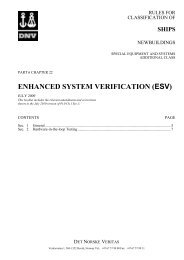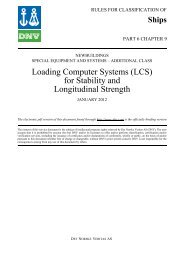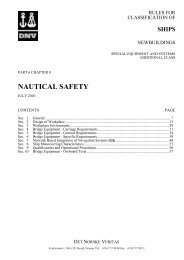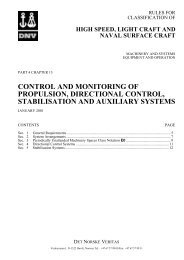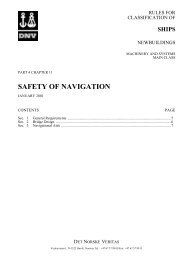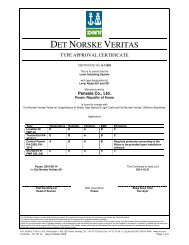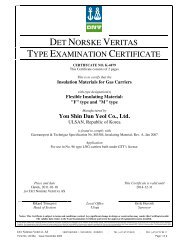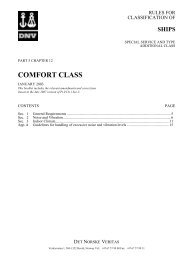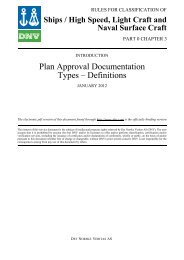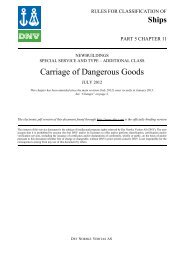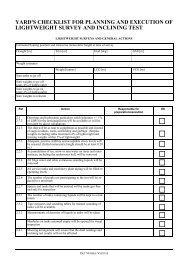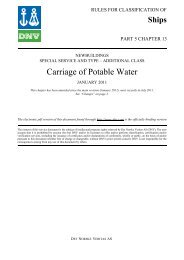Ship rules Pt.5 Ch.11 - Carriage of Dangerous Goods - DNV Exchange
Ship rules Pt.5 Ch.11 - Carriage of Dangerous Goods - DNV Exchange
Ship rules Pt.5 Ch.11 - Carriage of Dangerous Goods - DNV Exchange
Create successful ePaper yourself
Turn your PDF publications into a flip-book with our unique Google optimized e-Paper software.
DET NORSKE VERITAS AS<br />
Rules for <strong>Ship</strong>s, July 2012<br />
<strong>Pt.5</strong> <strong>Ch.11</strong> Sec.2 – Page 13<br />
703 Medical oxygen.<br />
Guidance note:<br />
Provided that the Administration requires that the guidelines in the MFAG in the IMDG Code supplement with<br />
respect to medical oxygen shall be met, the following shall be fulfilled:<br />
A 40 litre/200 bar medical oxygen cylinder shall be mounted in the ship's hospital, assembled for direct use, equipped<br />
with one flow-meter unit for supplying oxygen for two persons simultaneously. A complete portable set, ready for<br />
use, with a 2 litre/200 bar medical oxygen cylinder and a spare cylinder (also 2 litre/200 bar) shall also be available<br />
on board.<br />
The 40 litre/200 bar cylinders shall be stored in fixed supports connected directly to vessels steel structure within the<br />
ship's hospital. The cylinders shall be stored within a steel cabinet with natural ventilation to free air. Signboard<br />
warning <strong>of</strong> possible ignition caused by static electricity from clothing or open flame when medical oxygen is used<br />
(released) shall be posted on the cabinet.<br />
Alternative arrangements, which in the opinion <strong>of</strong> the Administration are equivalent, may be accepted.<br />
B 800 Portable fire extinguishers<br />
---e-n-d---<strong>of</strong>---G-u-i-d-a-n-c-e---n-o-t-e---<br />
801 Two portable fire extinguishers, each having a capacity <strong>of</strong> not less than 6 kg <strong>of</strong> dry powder or equivalent,<br />
should be provided when dangerous goods are carried on the weather deck, in open ro-ro spaces and vehicle<br />
spaces, and in cargo spaces as appropriate.<br />
(MSC.1/Circ.1275)<br />
These extinguishers are in addition to any portable fire extinguishers required elsewhere in the <strong>rules</strong>.<br />
Guidance note:<br />
Equivalent to dry powder may be either CO 2 or Foam. 1 kg <strong>of</strong> dry powder is equal to<br />
either 1 kg C0 2 or 1.8 litre Foam.<br />
---e-n-d---<strong>of</strong>---G-u-i-d-a-n-c-e---n-o-t-e---<br />
B 900 Insulation <strong>of</strong> machinery space boundaries and separation <strong>of</strong> cargo spaces<br />
901 Bulkheads forming boundaries between cargo spaces and machinery spaces <strong>of</strong> category A shall be<br />
insulated to “A-60” standard, unless the dangerous goods are stowed at least 3 m horizontally away from such<br />
bulkheads.<br />
(SOLAS Reg II-2/19 3.8)<br />
Guidance note:<br />
Machinery spaces <strong>of</strong> category A are those spaces and trunks to such spaces which contain:<br />
1) internal combustion machinery used for main propulsion; or<br />
2) internal combustion machinery used for purposes other than main propulsion where such machinery has in the<br />
aggregate a total power output <strong>of</strong> no less than 375 kW; or<br />
3) any oil-fired boiler or oil fuel unit.<br />
---e-n-d---<strong>of</strong>---G-u-i-d-a-n-c-e---n-o-t-e---<br />
902 Decks between cargo spaces and machinery spaces <strong>of</strong> category A shall be <strong>of</strong> “A-60” standard.<br />
In the case that a closed or semi-closed cargo space is located partly above a machinery space <strong>of</strong> category A<br />
and the deck is not insulated to “A-60” standard, dangerous goods are prohibited in the whole <strong>of</strong> that cargo<br />
space. If the un-insulated deck above such machinery space is a weather deck, dangerous goods are prohibited<br />
only for the portion <strong>of</strong> the deck located above the machinery space.<br />
903 In ship having ro-ro cargo spaces, a separation shall be provided between a closed ro-ro cargo space and<br />
an adjacent open ro-ro cargo space. The separation to be such as to minimize the passage <strong>of</strong> dangerous vapours<br />
and liquids between such spaces. Alternatively, such separation need not be provided if the ro-ro cargo space<br />
is considered to be a closed cargo space over its entire length and shall fully comply with the relevant special<br />
requirements <strong>of</strong> the regulation.<br />
(SOLAS Reg. II-2/19.3.10.1)<br />
904 In ship having ro-ro cargo spaces, a separation to be provided between a closed ro-ro cargo space and the<br />
adjacent weather deck. The separation to be such as to minimize the passage <strong>of</strong> dangerous vapours and liquids<br />
between such spaces.<br />
Alternatively, a separation need not be provided if the arrangement <strong>of</strong> the closed ro-ro cargo spaces is in<br />
accordance with those required for the dangerous goods carried on the adjacent weather deck.<br />
(SOLAS Reg. II-2/19.3.10.2)



